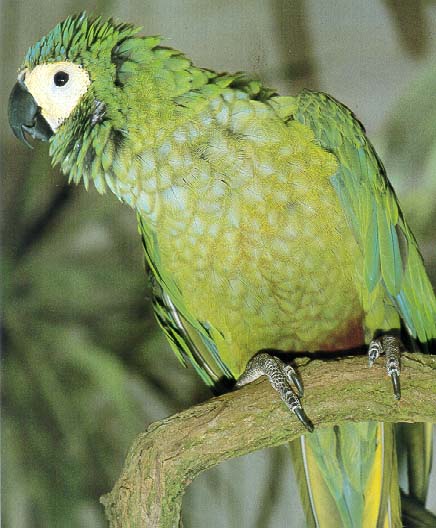
Red-bellied macaw(Orthopsittaca manilata or Ara manilata)
Phylum —chordata
Class — aves
Order — psittaciformes
Family — psittacidae
Genus – orthopsittaca
Appearance
The Red-bellied macaw is medium-sized, about 300 g (11 oz) in weight and about 46 cm (18 in) in length including its long pointed tail. The plumage is mostly green; the cere and much of the face are covered with bare mustard-yellow skin, and the irises are dark brown. The forehead is bluish. The chin, throat and upper chest are greyish with some green scalloping, and the lower abdomen ("belly") has a large maroon patch. The tail is long and tapered. The underwings and undertail are dull olive yellow. Adults have dark-grey beaks. The legs and feet are dark grey. Males and females have identical plumage, but males are usually larger and have larger heads. Juveniles are duller in color than adults and have a grey beak with a conspicuous white mid-line stripe running along the length of the culmen (top of the upper beak).
Habitat
The Red-bellied macaw has an extremely large range throughout the Amazon Basin of the North Region, Brazil, except in the northwest quadrant centered on a large region of the Rio Negro flowing from Colombia-Venezuela. It ranges through the Guianas including the Guiana Highlands into eastern Venezuela, the lower Orinoco River Basin and across to the island of Trinidad.
Behavior
Red-bellied macaws make reedy, high-pitched screams. They roost communally in the moriche palms, and large numbers can be seen at the roost sites at dawn and dusk. They choose large stands of these palms that have an overabundance of woodpecker holes as roosting sites. They sleep communally in these groups of hollows. Depending on the size of the hollow, between five and 10 birds sleep together. As dusk approaches, they all pile into these dormitories and sleep shoulder to shoulder.
Diet
Their diet consists almost exclusively of the fruit and seeds of moriche palm, which are 100% carbohydrate, 0% fat and very high in Beta-carotene.
Reproduction
Red-bellied macaws nest in cavities of dead moriche palm trees. There are usually two to four white eggs in a clutch. The female incubates the eggs for about 27 days, and the chicks fledge from the nest about 77 days after hatching. Juveniles reach sexual maturity in 2–3 years.
In the wild, this macaw lives between 15 and 20 years. In captivity, they can live to be between 30 and 40 years old.
In captivity
Macaws are very active and should be provided the largest cage that space and budget allows. Macaws should have adequate space to move freely between 2 perches. Example of an appropriate suspended cage size for Red-bellied macaws is 3 feet by 3 feet by 6 feet. Cages should be suspended 3 to 4 feet above the ground.
Ideally pet macaws can have a large cage outdoors for bathing and exercise. Red-bellied macaws are shy and should be provided with a retreat.
All macaws need plenty of energy for good health. Many of their natural foods, especially palm nuts are rich in oils, and calories. Macaws should be fed a formulated (pelleted or extruded) diet as a basis for good nutrition. Red-bellies can be difficult to convert to formulated diets and may require a predominately seed diet. The diet should be supplemented with fresh fruits and vegetables daily to add variety and psychological enrichment. Feed approximately 1/4 cup pellets daily. Also offer 1/4 cup of fresh fruits and vegetables. Give one to two small nuts, such as almonds, as treats. Red-bellied macaws readily eat peanuts but the nuts should be shelled and inspected for mold prior to feeding. Seed may be required. Vitamin supplements are not needed for birds that are eating a formulated diet but are needed for a seed diet.
Routine bathing or showering is vital to maintaining good plumage and skin condition. Birds can be misted and allowed to dry in a warm room or in the sun, or dried with a blow drier. An ideal way to bathe macaws is to put them in a cage outside, sprinkle them with the hose, and allow them to dry in the sun. Macaws are strong fliers. Most of the primary flight feathers (10 feathers closest to the tip of the wing) should be clipped to prevent flight.
 Russian
Russian
 English
English























